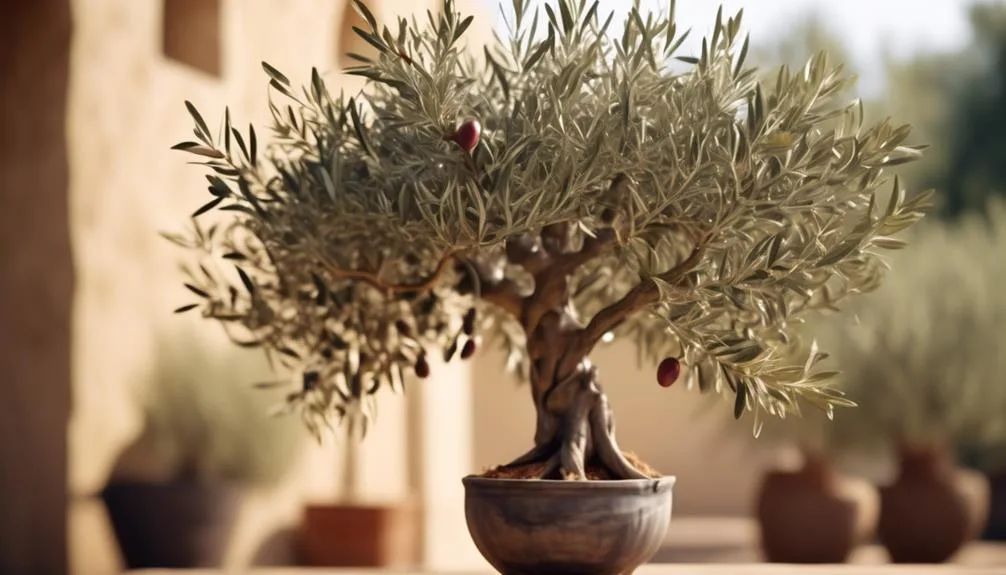Olive trees are pruned into specific shapes to improve fruit production and tree health. Traditional pruning techniques sculpt olive trees, impacting the quality and quantity of olives.
As you explore this topic, you'll discover the aesthetic and cultural significance of pruned olive trees and gain insight into achieving your desired tree shape.
Key Takeaways
- Shaping olive trees through pruning enhances their appearance, promotes better fruit production, and improves overall tree health.
- Traditional olive tree pruning techniques, such as open center and central leader pruning, have historical significance in Mediterranean culture and contribute to the iconic appearance of olive groves.
- The shape of olive trees directly impacts their fruit production and health, with certain shapes allowing for better sunlight exposure, airflow, and disease prevention.
- Pruned olive trees hold aesthetic and cultural significance, representing the captivating beauty and rich heritage of olive cultivation, showcasing expertise and artistic sensibility, and symbolizing resilience and interconnectedness with the land.
Benefits of Shaping Olive Trees
Regularly shaping your olive trees not only enhances their appearance but also promotes better fruit production and overall tree health. Pruning in specific shapes, such as the open center or vase shape, allows for improved sunlight exposure and air circulation throughout the tree. This, in turn, leads to better fruit development and increased yield.
By shaping your olive trees, you're ensuring that they maintain good structural integrity, reducing the risk of limb breakage due to heavy fruit loads. Additionally, pruning encourages the growth of new, healthy branches, which are essential for the tree's longevity and productivity.
Properly shaped olive trees are also less prone to diseases and pest infestations, contributing to overall tree health and vitality. So, by investing time in shaping your olive trees, you aren't only enhancing their visual appeal but also reaping the benefits of improved yield and tree health.
Traditional Olive Tree Pruning Techniques
To maintain the health and productivity of your olive trees, it's essential to understand the traditional pruning techniques that help shape the tree and promote fruit production. Olive tree pruning techniques have been honed over centuries and hold historical significance in Mediterranean culture.
One traditional method is called 'open center pruning,' where the main trunk is allowed to grow tall, and the lateral branches are pruned to create an open, vase-like shape. This technique maximizes sunlight exposure and air circulation, promoting fruit production and reducing the risk of disease.
Another method is known as 'central leader pruning,' where the central trunk is encouraged to grow vertically, with lateral branches pruned to maintain a pyramidal shape.
These techniques not only ensure a bountiful harvest but also contribute to the iconic and picturesque appearance of olive groves in the Mediterranean.
Impact of Tree Shape on Olive Production
The shape of your olive tree plays a crucial role in determining its fruit production and overall health. Yield optimization is influenced by the tree architecture, as certain shapes allow for better sunlight exposure and airflow, leading to increased fruit production.
Pruning your olive tree into an open vase shape, for instance, promotes better fruit quality and yield. This shape facilitates easy access to sunlight, essential for fruit development, and enhances air circulation, reducing the risk of diseases.
Additionally, the environmental impact is significant, as a well-maintained tree shape allows for efficient water usage and nutrient distribution, ultimately benefiting the overall health of the tree and the quality of the olives.
Aesthetic and Cultural Significance of Pruned Olive Trees
Discover the captivating beauty and rich cultural heritage embodied by pruned olive trees, as they stand as living legacies of time-honored traditions and artistic expression in the Mediterranean landscape.
The aesthetic appeal of pruned olive trees lies in their sculptural forms, which create a striking visual impact in the agricultural terraces and countryside. These trees, carefully shaped over generations, not only enhance the natural beauty of the landscape but also symbolize the enduring cultural significance of olive cultivation.
Each pruned olive tree reflects the expertise and artistic sensibility of the pruner, showcasing a harmonious blend of human intervention and natural growth.
In Mediterranean cultures, pruned olive trees hold deep cultural symbolism, representing resilience, longevity, and the interconnectedness of people with the land. Their presence serves as a reminder of the enduring traditions and values that have shaped the region for centuries.
How to Prune Olive Trees for Desired Shapes
Consider the unique characteristics and growth patterns of your olive trees to effectively prune them into desired shapes that enhance both their aesthetic appeal and productivity. When shaping your olive trees, here are some pruning techniques and shaping methods to keep in mind:
- Single Trunk: To create a single-trunk olive tree, carefully select one strong, central leader and prune away any competing shoots.
- Vase Shape: Encourage an open center by removing the central leader and shaping the tree into a vase-like form with an open canopy.
- Espalier: Train your olive tree to grow flat against a support structure, such as a wall or trellis, by regularly pruning and tying the branches.
Conclusion
In caring for olive trees, the unique shapes formed through pruning serve a crucial purpose in maintaining the tree's health and productivity. These shapes also hold cultural and historical significance in the practice of olive cultivation.
By employing proper pruning techniques, you can't only enhance the visual appeal of the trees but also ensure a bountiful harvest for years to come.
Happy pruning, and may your olive trees flourish with abundance and beauty.

